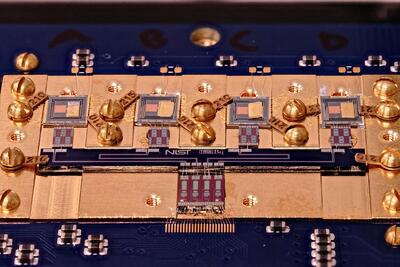Precise measurement of radioactivity in tiny samples

Researchers at the US National Institute of Standards and Technology (NIST) claim to have developed a new and faster method for detecting and measuring the radioactivity of minuscule amounts of radioactive material.
Their innovative technique, known as cryogenic decay energy spectrometry (DES), could have far-reaching impacts, from improving cancer treatments to ensuring the safety of nuclear waste clean-up. It has been described in the journal Metrologia.
Rapid detection and measurement
Traditional methods have proved effective at either measuring the amount of radioactivity or identifying which radioactive atoms are present — not both. Fully characterising a sample thus required the use of multiple techniques and intricate procedures using additional materials called tracers or calibrants.
The new method offers a streamlined approach, identifying radioactive elements and quantifying their level of radioactivity in even tiny samples — without needing extra materials. This allows scientists to better monitor, use and safeguard radioactive materials that affect public health and safety.
“Instead of waiting months for results, we can now get a full radioactivity profile in just a few days from a tiny sample,” said NIST physicist Ryan Fitzgerald.
The key to the technique is a transition-edge sensor (TES), a high-tech device widely used to measure radiation signatures. The TES provides the capability to record individual radioactive decay events, in which an unstable atom releases one or more particles. By building up data from many individual decays, researchers can then identify which unstable atoms, known as radionuclides, produce the events.
“The TES is much more advanced than a familiar Geiger counter or other detectors used today,” Fitzgerald said. “Instead of just clicking to indicate radiation, or giving a blurry indication of the decay energy, it gives us a detailed fingerprint of what’s there.”

The TES device operates at extremely low temperatures, near absolute zero. When a radioactive decay occurs in a sample, the energy released is absorbed by the TES. This absorbed energy causes a tiny change in the electrical resistance of the TES.
The researchers precisely measured this change in resistance, which provides a high-resolution ‘energy signature’ of the decay event. By analysing the detailed energy spectrum from multiple events, the researchers can identify the specific radioactive atom undergoing decay. This is possible because different radioactive atoms release unique energy signatures when they decay.
Inkjet precision
In their method, the researchers use a specialised inkjet device to carefully dispense tiny amounts, less than 1 millionth of a gram, of a radioactive solution onto thin gold foils. These gold foils have a surface dotted with tiny pores just billionths of a metre in size. These nanopores help to absorb the tiny droplets of the radioactive solution.
By precisely measuring the mass of the solution that was dispensed using the inkjet and then measuring the radioactivity of the dried sample on the gold foils, the researchers can calculate the radioactivity per unit mass, or the ‘massic activity’, of the sample. This inkjet method allows them to work with extremely small amounts of radioactive material and still get an accurate measurement of its radioactivity.
The potential applications are vast. In medicine, this technology could help ensure the purity and potency of radioactive drugs used in cancer treatments. For nuclear energy, it could quickly identify radioactive composition of reprocessed fuel, speeding development of new advanced reactors.
Redefining radioactivity measurement
The newly reported research is the first step in a larger effort, known as the True Becquerel (TrueBq) project, to transform how we monitor and characterise radioactivity. The project aims to develop a more comprehensive measurement system that can handle a wide range of radioactive substances, including complex mixtures. It will integrate a precision mass balance system with the TES device to measure the massic activity of radioactive materials with unprecedented accuracy.
This new approach is said to represent a significant improvement over traditional workflows, which often involve multiple methods, chemical processing, and the use of chemical tracers and standards. By streamlining the measurement process, TrueBq is expected to reduce the time required for analysis while simultaneously increasing accuracy.
While TrueBq’s current focus is on improving measurements at NIST itself, researchers have long-term aspirations for the technology. In the future, they hope to develop more portable and user-friendly versions of the system that could be deployed outside of NIST for critical applications in fields such as medicine, environmental clean-up and nuclear waste management.
MRI scanner to advance medical breakthroughs at Monash
Siemens Healthineers' MAGNETOM Cima.X 3T is claimed to be Victoria's most advanced,...
Virtual pathology streamlines rapid onsite evaluation
Technology from Grundium, a specialist in digital imaging for pathology, has been shown to match...
Cannabis detected in breath from edibles
Researchers say they have made the first measurement of THC in breath from edible cannabis, in a...



